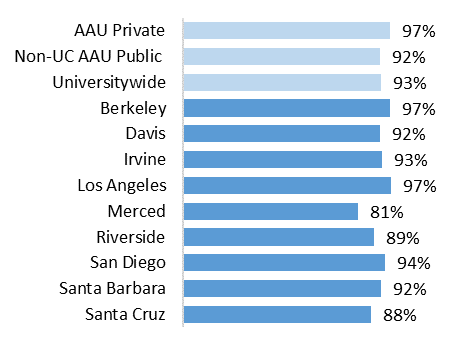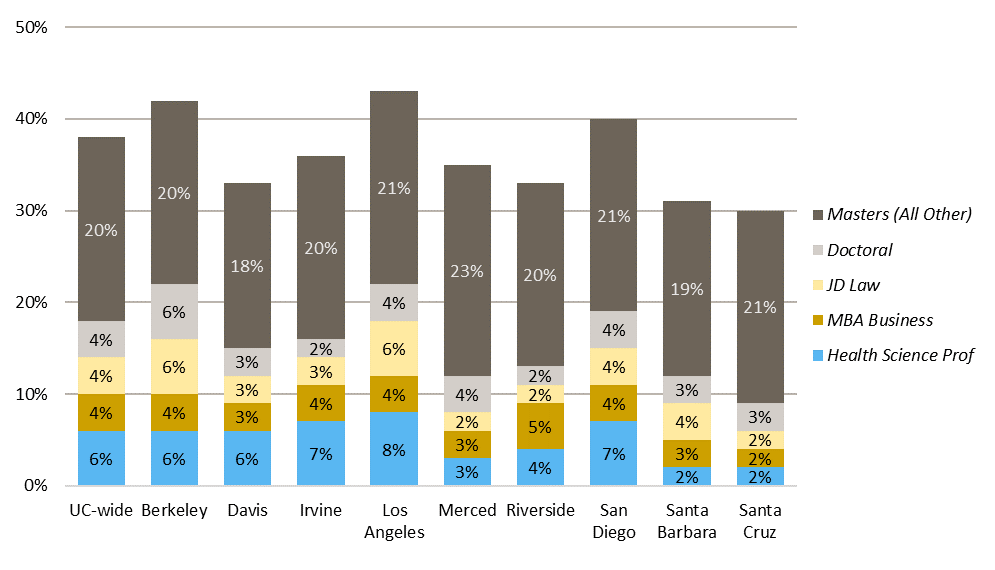Trends in graduation rates and goals
Two traditional measures of student success are graduation rates and time to degree. By both measures, UC’s undergraduates are highly successful. The four-year graduation rates for freshmen have risen significantly over the past 16 years — from 46 percent for the 1997 entering cohort to 70 percent for the 2015 cohort. The most recent six-year graduation rate, for the 2013 entering cohort, is 85 percent (3.1.1), which has increased by six percentage points since 1996. The six-year graduation rate is 88 percent when this measure includes students who transfer to non-UC institutions (3.1.2) and still graduate within six years. In addition, time to degree has steadily improved. The most recent freshman entrants are taking an average of 4.17 years to graduate, an improvement on the 2000 cohort, which took 4.33 years.
Transfer entrants have made similar gains, with two-year graduation rates increasing from 37 percent for the 1997 entering cohort to 59 percent for the 2017 cohort (3.1.3). The most recent four-year graduation rate for transfers (2015 entering cohort) is 89 percent, an increase of about ten percentage points since 1997. The average time to degree is 2.4 years for the 2012 cohort, an improvement from 2.6 years for the 1996 cohort (3.1.8).
Although graduation rates have increased for all students, there are still gaps in rates between subgroups (3.1.4, 3.1.5, 3.1.6, and 3.1.7). New-generation students — that is low-income students, first-generation students, and students from underrepresented groups (URGs) — have lower average graduation rates, especially four-year graduation rates for freshmen and two-year graduation rates for transfers. Assuming the net cost of attendance ranges from about $11,000 for very-low-income California resident students to about $30,000 for California residents in the highest income bracket, and assuming that the median early-career salary is around $40,000, students graduating in four years as opposed to six could benefit from about $100,000 to $150,000 in lower costs and additional wages.
UC’s goal is to enable all entrants to complete their undergraduate degrees in a timely fashion and to ensure that their education prepares them to be the next generation of leaders for California, the nation, and the world. In its UC 2030 goals, the University of California seeks to increase the four-year graduation rate from 68 percent (2014 cohort) to 76 percent by 2030, and two-year graduation rates from 57 percent (2016 cohort) to 70 percent by 2030.
Improving graduation rates and eliminating gaps
The UC Office of the President and campuses have employed predictive analytics to obtain a better understanding of factors that influence graduation rates. Findings indicate that pre-college factors such as academic preparedness measured by high school GPA, the rigor of student’s high school or transfer courses, standardized test scores, and demographics are related to, but only explain a small portion of, variance in time to degree and graduation rates. Campus climate, access to courses, student sense of belonging, student engagement in academic and civic activities, and success in the first year at college, among many other factors, are important to college completion and timely graduation.
To address challenges facing students and campuses, and reach UC’s goal of improving graduation rates, UC campuses have identified, and where possible are expanding, a wide range of programs to promote the academic success of undergraduates and eliminate gaps in graduation rates, particularly for new generation students. These include expanding orientation, advising, and counseling services; increasing on-campus work opportunities; redesigning and removing achievement gaps in entry courses with large enrollments; streamlining course prerequisites, course sequences, and degree requirements; summer research and summer bridge programs; increasing access to summer session courses; developing pedagogical strategies for the diversification of classrooms and instruction; and conducting learning analytics to assist students who might need additional support.
Students who take longer to graduate leave with more debt, have lower lifetime earnings, and are less likely to go onto graduate school. Recognizing the importance of early student success for on-time graduation, UC campuses are specifically making efforts to improve first-year student success. Many campuses offer summer bridge, transfer edge, extended orientation, and/or first-year seminars to assist students with the transition to UC. Campuses are also making advising mandatory for first-year students. Many UC campuses offer first-year students the opportunity to work on a research project with a faculty member. UC recently launched the systemwide First-Generation Faculty Initiative, which connects first-generation students to both faculty and staff mentors.
Undergraduate outcomes
The number of undergraduate degrees awarded by UC grew from about 32,900 degrees in 2000–01 to about 49,400 degrees in 2014–15, and 57,000 degrees in 2018–19 (3.3.1). Increases in the size of the entering freshman class and improving graduation rates contributed to this growth. UC has proposed a multiyear framework that seeks to improve degree attainment and produce 200,000 more degrees in addition to the projected baseline of one million degrees over the next 15 years, between 2015–16 and 2029–30. About 80 percent of these additional degrees (160,000) would be at the undergraduate level.
UC undergraduate alumni enroll at graduate schools or work in various industries. Four years after graduation, more than one-quarter of bachelor’s degree recipients have enrolled in graduate or professional programs. More than half are working in key industries such as health care, K–12 education, finance & insurance, public administration, social assistance, higher education, engineering, and internet and computer systems. Many alumni work in industries that closely align with the majors they chose. By ten years after graduation, 56 percent of engineering & computer science majors work in engineering, manufacturing, or internet and computer systems; 30 percent of life science majors work in health care; and 34 percent of arts & humanities majors are working in K–12, higher education, or performing arts and entertainment.
UC alumni working in California surpass the typical earnings of other California bachelor’s degree recipients (aged 25 and over) by six years after graduation. The earnings trajectory of UC alumni increases rapidly; ten years after graduation they double what they were earning two years after graduation, on average (3.3.2). Economic success is prevalent for all socioeconomic groups, including students whose families qualified for federal Pell Grants. Within five years of graduation, the majority of Pell Grant recipients earn an average income higher than their parents’ combined incomes during the time those students attended UC (approximately $50,000).
Looking forward
UC campuses have identified promising strategies that, if increased in scale, could help achieve ambitious UC 2030 goals. The University has not yet received state funding to expand these programs and strategies. Recent declines in first-year retention rates signal that future UC graduation rates could also decline and the gaps for new generation students could grow. Furthermore, it is unclear how the COVID-19 pandemic and shift to remote instruction could affect student success and retention.
For more information
Graduation rates and goals by campus, gender, Pell, residency status, race/ethnicity, and other factors
UC 2030 systemwide and campus dashboards
Eliminating gaps in timely graduation
UC’s undergraduate alumni outcomes, including employment industries and earnings
UC’s report on Advising Strategies to Support Timely Graduation
Total degrees awarded by degree type, campus, gender, and race/ethnicity
UC’s role in enabling low-income students to achieve intergenerational economic mobility
UC First-Generation Faculty Initiative



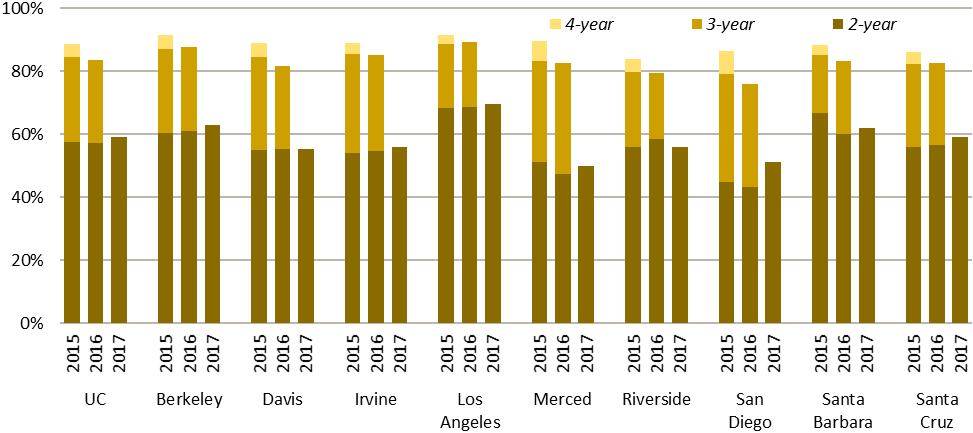
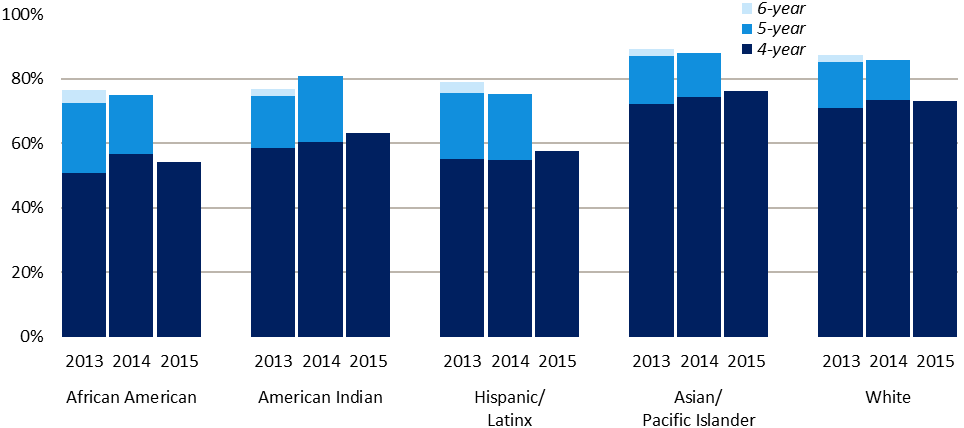
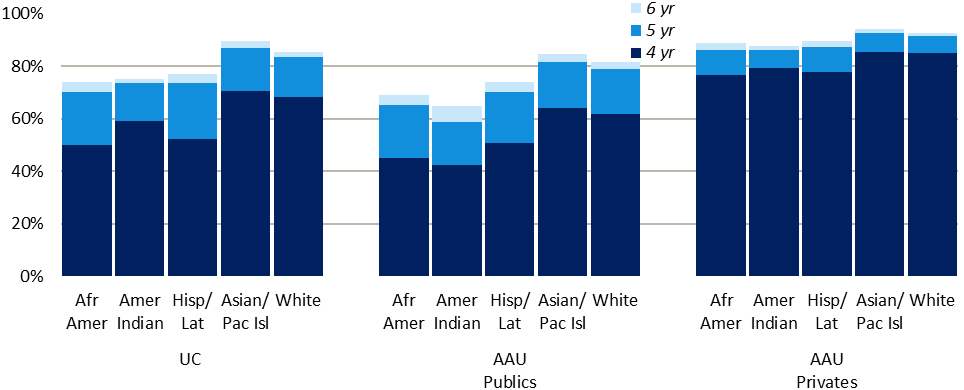


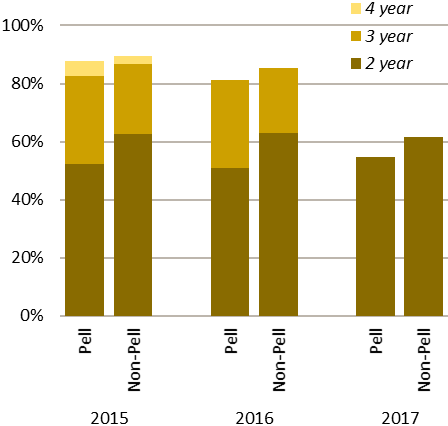
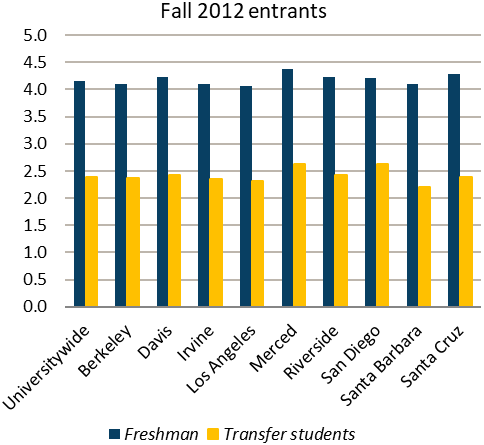
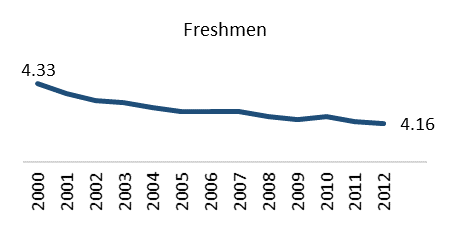
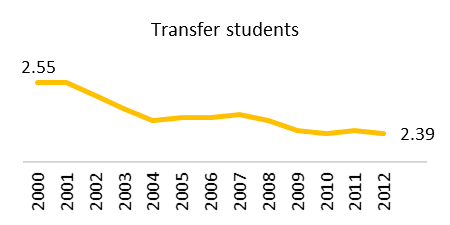 Source: UC Corporate Student System. Average time to graduation includes only students who graduated from UC within seven years.
Source: UC Corporate Student System. Average time to graduation includes only students who graduated from UC within seven years.
